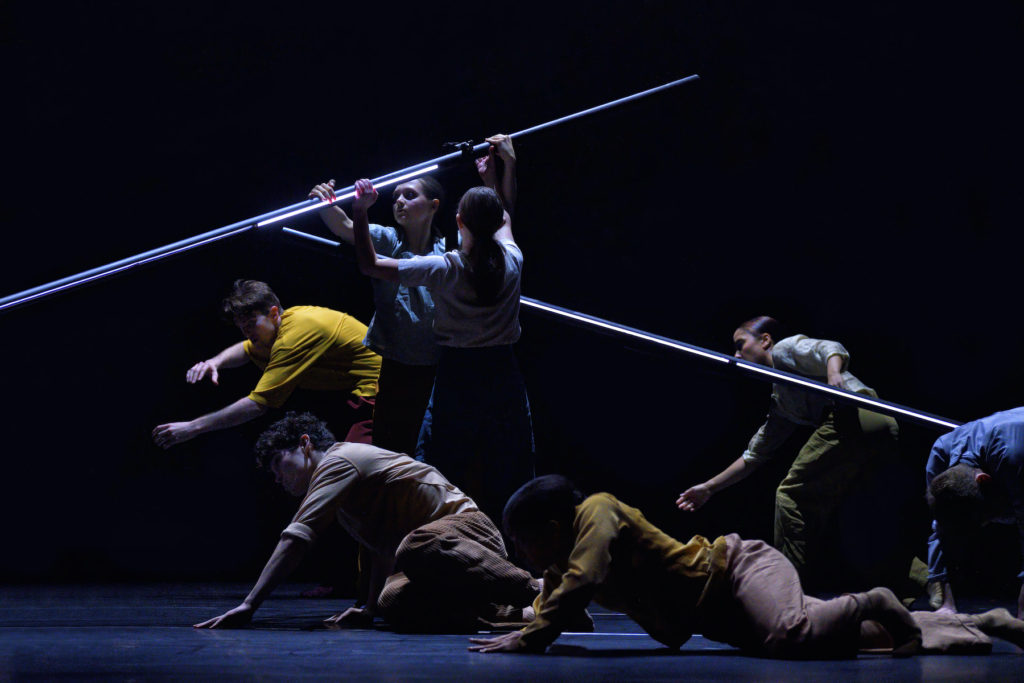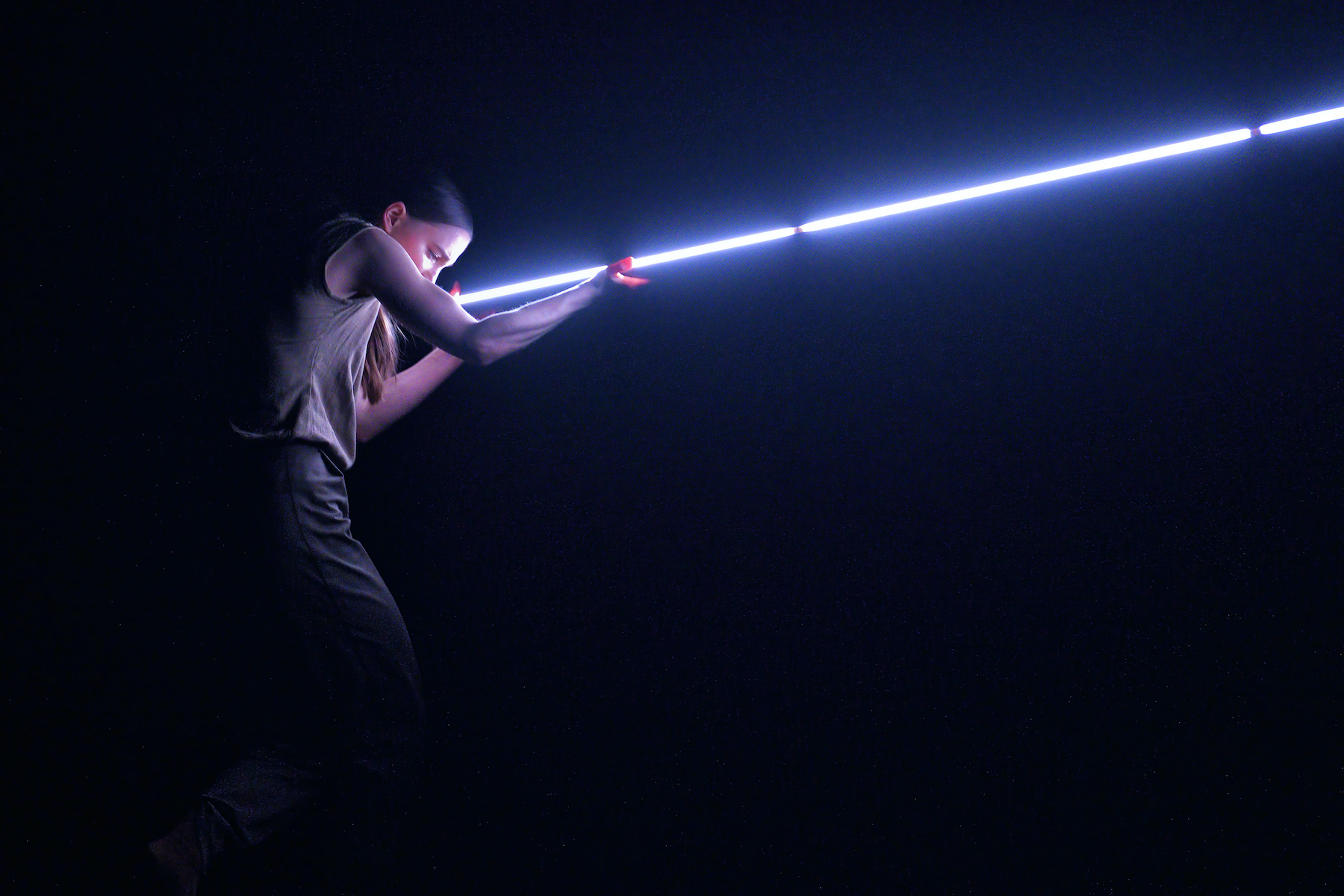Ballet BC Season Finale: Dark imaginations - Vancouver Ballet Society
- Home
- Reviews 2020 - 2023
- Ballet BC Season Finale: Dark imaginations

By Kaija Pepper
Everything will be ok — despite the reassuring title of the final work on Ballet BC’s May 12-14 triple bill at Vancouver’s Queen Elizabeth Theatre, the visions presented onstage were dark ones. There is good news behind the scenes at the company — they will soon be moving into their own home on Granville Island — but, it has to be said, the world at large is not having its brightest moment. The artists represented on the bill, titled “What If,” responded to that larger, looming reality.
Artistic director Medhi Walerski programmed a local choreographic duo first: David Raymond and Tiffany Tregarthen, whose Strange Attractor showed the invention familiar from previous creations with their own company, Out Innerspace. Props in their work can have minds of their own; here, at one point a bevy of black umbrellas waddle onstage, transformed by the choreographers into strange animate creatures. The couple tend to work ideas thoroughly, and while it took a while for the magic to carry on the Queen E’s large dark stage, the details slowly added up to pack a wallop.

Strange Attractor opened and closed with a nostalgic touch, set to popular songs. First, Jaycee Hill’s 1956 Crash Out, about San Quentin and an unfaithful lover; to close, Sandy Denny’s 1967 classic, Who Knows Where the Time Goes, in a light rendition by multi-talented Jermaine Maurice Spivey (a former colleague of Raymond and Tregarthen’s: all three were in the original cast of Crystal Pite’s Revisor).
A powerful drum rhythm by Istanbul’s Cevdet Erek, in the middle section, held the dancers within its compelling beat. The full company roster of 19 (including six emerging artists) moved together like clockwork: hands fluttered and pulsed, bodies shuddered and jolted in murky, muddy waves of movement.
The final part circled back to song, Denny’s lyrics expressing another small human perspective on love and loss. Finely crafted choreographic details stood out in the gloom (lighting design by James Proudfoot). A small group of women sweeps past; a single dancer catches the eye — Miriam Gittens, who spins round while tipped recklessly forward on one leg, the other outstretched to the back, her body suspended in a brief storm of opposing forces.
Connection between large-scale groups of bodies has become a key theme in choreography worldwide, with Pite considered the master of the form. But Raymond and Tregarthen create something recognizably theirs, with their own whimsical styling.

Dorotea Saykaly begins RELIC with her cast of 12 each standing under their own shaft of light, trying out a series of poses. Even when they take voluptuously curved shapes, it seems more out of curiosity to experiment with the possibilities of human form than from sensual expression.
There’s a reason for the movement’s robotic precision and repetition: a science fiction theme drives RELIC. Among the clues to this is a recorded voice over asking, “What have you replicated?” For the final scene, the ensemble wear white lab coats. And the soundtrack by Riku Mäkinen revs up like a spacecraft preparing for liftoff; there are no warm lyrics here. But there are some nifty superhuman moves: Sidney Chuckas (an emerging artist in the opening night cast) has legs with the power of steel and the flexibility of rubber: from a low split-legged dip near the ground, he rises to stand like he’s being sucked upright.
Montreal-born Saykaly was on the bill as the inaugural recipient of the Emily Molnar Emerging Choreographer Award. A former dancer with Compagnie Marie Chouinard, she is currently on leave from her position as a dancer with Sweden’s GöteborgsOperans Danskompani.
Another European-based artist closed the evening: Germany’s Felix Landerer, who runs his own company in Hanover. Landerer’s Everything will be ok was danced under more gloomy half-light (by Bonnie Beecher, who also designed the lighting for RELIC). Intensifying the darkness was Christof Littmann’s depressingly downbeat industrial soundscape: it did not feel like everything would be okay.

The stage design (by Landerer) featured two long glowing poles — the stars of the piece. Everything will be ok was built around the light poles, which the cast of 14 take turns pushing round in slow graceful arcs. When not so engaged, they keep busy either avoiding or being drawn toward the poles, tumbling underneath to escape collision.
One applauds Ballet BC for supporting new work, something they are known for, and are rightly proud of. But programming a bill of three premieres is risky in a mainstage show, and here there was not enough variety of mood to sustain a long evening. There was certainly no bright or lively closing piece. Everything will be ok ended on a literal thumbs-up from a dancer standing downstage, delivered directly toward the audience, but it was not a widely shared sentiment. Unlike most opening nights at Ballet BC, this one did not end with a feel-good standing ovation by the company’s many fans and supporters.

